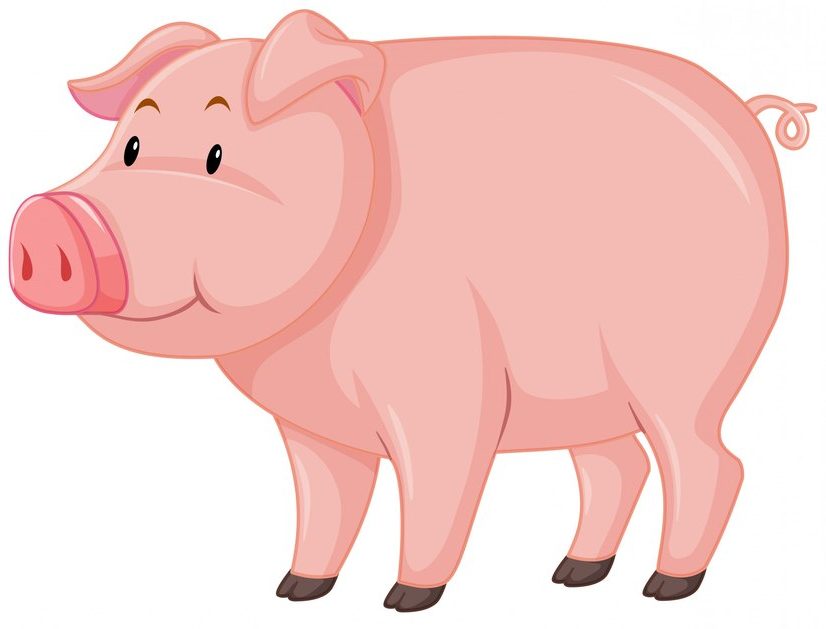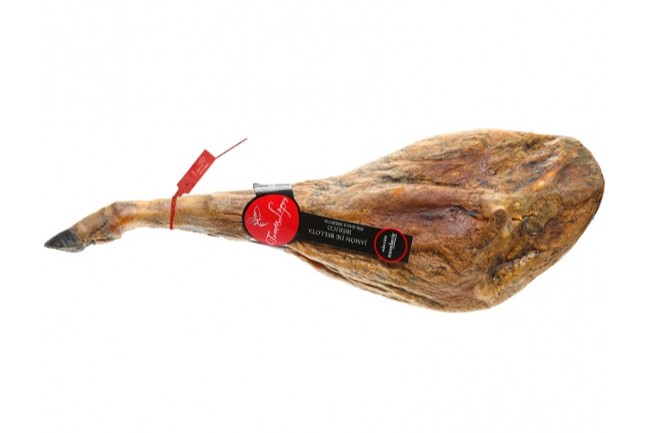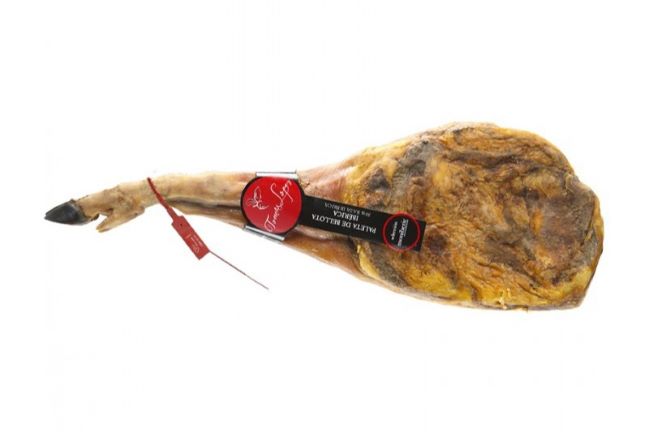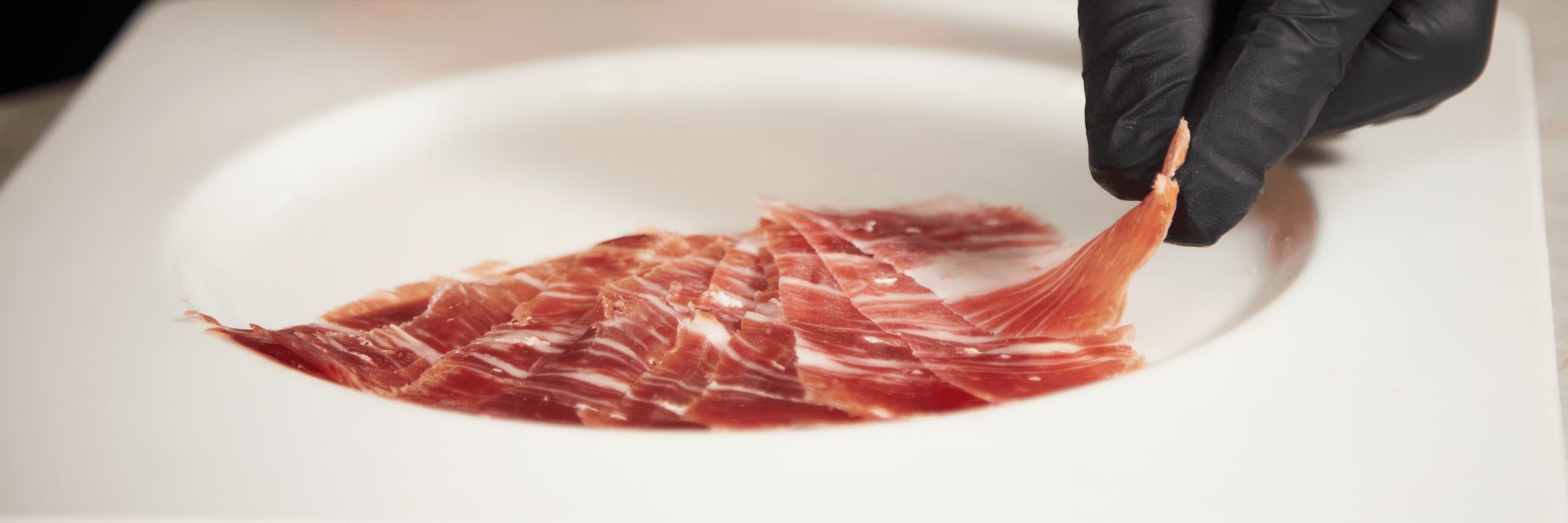Índice de contenidos
ToggleWhen someone comes into our Iberian products store, one of the most frequently asked questions is:
“What’s the difference between a shoulder and a ham?”
And it’s no wonder. At first glance, they may seem very similar, but the truth is, they have important differences that influence flavor, size, price, performance, and even the way you cut them. In this article, we’ll explain everything clearly and simply so you know which one to choose. And if you’d like to try them later, we’ll leave you some links at the end so you can buy them directly from our online store.
The most basic and at the same time most important difference between shoulder and ham is anatomical.
Ham comes from the hind legs of the pig.
The shoulder, on the other hand, comes from the front legs.
This distinction not only affects the size and weight of the cut, but also its bone structure and the ratio of meat, fat, and bone. For example, a pig’s hind legs are more muscular, which translates into greater meat yield and, generally, longer curing time.
👉 If it’s your first time slicing at home or you’re looking for something more manageable, you might be more interested in a whole Iberian shoulder.
👉 If you prefer traditional slicing and want a piece that lasts longer, a whole Iberian ham will be ideal.

One of the easiest ways to differentiate a shoulder from a ham is by its size and shape:
The Iberian ham (left) typically weighs between 7 and 9.5 kg. It has a long, slender shape, resembling a teardrop. Its longer leg provides leaner meat.
The Iberian shoulder (right), on the other hand, weighs between 4 and 6 kg. It is shorter, with a more rounded and compact shape, and a higher proportion of bone and fat in relation to the total.
This aspect has practical implications. For example, if you’re looking for a more manageable piece to carve at home or if it’s your first time tackling a ham holder, a shoulder ham may be a more comfortable and less intimidating option.


Curing time is one of the factors that most influences the flavor and texture of these products. And this is where the differences also become evident:
Due to its larger size and thickness, ham requires more time to cure optimally. At Moniberic, the curing time for an Iberian ham can last between 30 and 48 months, depending on the type of pig (cebo, cebo de campo, or bellota) and the microclimate where the curing takes place.
The shoulder, being smaller, requires a shorter period of time, generally 18 to 30 months. This allows it to be ready sooner, although its curing must also be precise to ensure a juicy texture and balanced flavor.
This artisanal process requires experience and care. It’s not just about “letting the piece dry,” but also about knowing exactly when it’s ready for consumption, something our expert ham makers master perfectly.
Although both Iberian ham and shoulder share many organoleptic qualities (smell, taste, texture), each offers a slightly different experience:
The shoulder has a more intense flavor in each slice. This is due to the smaller size and the different proportion of infiltrated fat and bone that concentrates the flavors. Its texture is generally more fibrous and juicy, ideal for those who enjoy a deeper, meatier flavor.
Ham, on the other hand, offers a milder, rounder flavor, with nuances that gradually unfold on the palate. Its texture is silkier and more creamy, making it a favorite choice for those seeking an elegant and persistent bite.
In the end, it all depends on personal preference. Some people fall in love with the character of the shoulder, while others prefer the subtlety of the ham. The ideal is to try both and find out which one wins you over.
👉 If you love a strong flavor, try a Tomás López sliced 100% Iberian acorn-fed shoulder.
👉 If you prefer something softer and rounder, a sliced Iberian ham may be your best choice. Visit one of our Moniberic stores and our experts will advise you on the ham you’re looking for.

The shoulder is more economical, simply because it is smaller and yields less meat.
Ham has a higher price, but it also offers greater yield: more usable slices per piece.
👉 If you’re looking for a gift, a surprise, or a treat for yourself, a 5J 100% acorn-fed Iberian ham is a safe bet.
👉 If you prefer something more affordable for everyday use, a Tomás López 50% field-fed Iberian shoulder ham may be a great fit.

Ultimately, there’s no one option that’s better than another, but rather one that’s more suited to each moment and each taste. If you’re looking for a piece for a special occasion that lasts a long time and offers smooth, complex nuances, Iberian ham may be your best ally. If you prefer a more concentrated flavor in a more manageable piece at a more affordable price, Iberian shoulder ham is a magnificent choice.
And remember: whether you choose a shoulder or an Iberian ham, at Moniberic we guarantee that you’ll be taking home a product of the highest quality, cured with care and passion, respecting the ham-making tradition that makes our products a true gastronomic gem.
Visit our store and be seduced by the best Iberian products!
Contactar